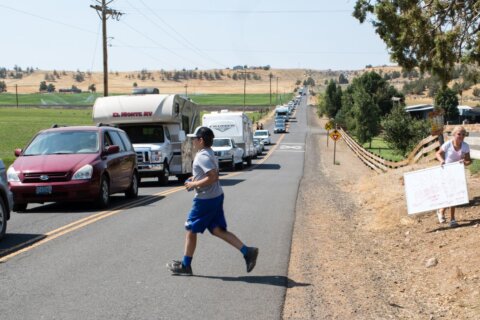WASHINGTON — Tuesday will mark the official end of summer for many, as school resumes and summer vacations become fond memories — and quiet summertime commutes, too.
Early September is when many motorists start to adjust to a busier fall commute. That learning curve over the years has resulted in the Tuesday after Labor Day being nicknamed, “Terrible Traffic Tuesday.”
“Terrible Tuesday signals the return of 60 percent of area commuters driving to work alone at least three days a week, and the return of 1.9 million vehicle trips per workday in Washington, D.C.,” said John Townsend, with AAA mid-Atlantic.
Traffic experts dedicated to studying D.C. traffic patterns agree that this Tuesday will prove a slow one for many area drivers.
“There’s this shock in September, when everybody gets back into school and back to work,” said facilitator Taran Hutchingson with the Metropolitan Area Transportation Operations Coordination in College Park.
For people who take I-270 from I-70 to the Beltway, the day after Labor Day last year saw a roughly 20-minute jump in commute times during the morning and afternoon rush.

That said, even Tuesday’s traffic volume might pale in comparison to the days that follow, Hutchinson said, pointing to data from some of the D.C. area’s biggest highways and interstates.
Statistics from I-66 in Virginia, the Dulles Toll Road, the Capital Beltway, I-395 and even I-295 through D.C. show delay times increasing all the way through October.
With results varying from year to year, though, there’s no way to predict exactly what the seasonal transition may have in store this time around.
“There was probably a 15-percent increase [in travel times] from one month to the next in 2017 — in previous years we have seen that up to 25 percent,” Hutchinson said.
Unsurprisingly, the Capital Beltway is one of the busiest interstates during morning and afternoon rush hours. Last July, it would take someone an average of just under two hours to travel the entire inner or Outer Loop during afternoon rush on a Tuesday, according to data provided by the MATOC.
In October, that time increased to two-and-a-half hours.
Time is money, and according to estimates, delays on last year’s Tuesday after Labor Day clogged roadways enough to cost drivers a combined $3.5 million across the capital region. That’s almost 146,206 hours drivers spent sitting in traffic.
Believe it or not, that wasn’t as expensive as delays can get. According to MATOC, Sept. 28 of last year cost drivers a combined $5.5 million dollars, from over 220,000 hours of delay time for motorists.
Enhancing those delays are what Hutchinson calls ‘one-off events,’ including crashes and disabled vehicles, which can often cause far-reaching and long-lasting travel headaches.
“On a given day, we’re operating beyond capacity, so little things can really upset the balance,” Hutchinson said.
Hutchinson said his best advice for drivers is to plan ahead and have backup plans to deal with these ‘one-off events’ along your commute. It helps to know your options for using public transportation, too.
As for his work studying the roads, Hutchinson said pouring over traffic data allows his office to better supply local and state agencies with information to better prepare for the busiest days.
“So they know where to look, and where to stage their equipment so that when the crashes occur, when the disabled vehicles occur, they can get them out of the road quickly, safely and get traffic moving again,” he said.








